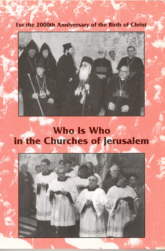MENU
Main
Catholic
Church
Roman
Catholics
Eastern
Catholics
Orthodox
Church
Greek
Orthodox
RussianOrthodox
Coptic
Orthodox
Syrian
Orthodox
Ethiopian
Orthodox
Armenian
Church
Protestants
Oikoumene
The
Heads
of
the Churches
of
Jerusalem
The
History
of
the Church
of
Jerusalem
Crusaders
Palestinian
Christians:
Challenges
and
Hopes
|
© Alexander
Deriev
 |
Crusaders
|
Having been conquered by the Turkish Seljuks, Jerusalem was to
meet further turbulence. A horde of soldiers and common-folk gathered
in Europe to "liberate" the Christian holy places in Jerusalem. The
reasons were manifold. The harsh treatment the Christians, both locals
and pilgrims, who suffered under the Turks in the eleventh century arose
the ire of the Christian rulers in Europe. Combined with this ire,
there was a fear of the steadily expanding Muslim power approaching Europe
from the East. Social upheaval in Europe created a huge rootless
population. These people became easy targets for charismatic preachers
propagating participation in the campaign to liberate the Tomb of Christ
in Jerusalem. Promises of a guaranteed place in heaven for those
who joined the Crusades as well as expectations of the breakthrough of
a Messianic era when the Tomb of Christ will be "liberated" added to the
enthusiasm of the crowd.
Although the greater part of the army of the first Crusade perished
during the long and harsh march to Jerusalem, those who finally arrived
were so filled with ecstasy that there were no limitations to their rampaging.
The attack of the Crusaders on Jerusalem and its population was so brutal
that in the East the very word “Crusader” has come to mean cruelty.
It is said that the streets were flooded with blood. No distinction
was made among the different groups of the local population in Jerusalem.
Jews, Eastern Christians, and Muslims were slaughtered in the same manner.
However, it seems that Muslims expelled most of the Christians from Jerusalem
shortly before the attack. The Orthodox Patriarch escaped, or was
expelled, and the Latin Patriarch was elected immediately by the Crusaders.
Soon after the brutal conquest of Jerusalem and the establishment
of the Kingdom of Jerusalem in 1099, the Crusaders recognized the presence
of the Eastern Churches. The Orthodox Churches were invited to return
to the holy places and to the abandoned monasteries, though under supervision
of the Crusaders. Although both theological and political issues
caused constant suspicion between the Eastern and Western Christians, in
time Jerusalem regained its colorful character.
The Crusader period brought a dramatic change for Christianity
in the Holy Land, causing hard consequences for the Eastern Christians,
the consequences of which they still suffer in their relations with Muslims.
At the same time, the Crusaders also built up the country in many ways.
They restored many churches and erected impressive new church buildings
and fortresses which can still be seen today. On the social level,
they established many different institutions such as hospitals and hostels.
The three main orders that built up the Holy Land were the Order
of the Hospitallers of St. John (which was the main custodian for the Church
of the Holy Sepulchre); the Order of the Templars (which converted the
Mosques of the Al-Aqsa area to Templum Domini and Templum Salomoni); and
the Order of the Teutonic Knights (which had its center in Acre).
The members of these orders worked as soldiers, doctors, architects, and
monks.
The Crusaders never could get a real foothold as rulers of the
Holy Land because they were always dependent on support — both material
and human — from Europe. They ruled over people who never accepted
them as their authority. The Crusaders came to power much because
of deep disintegration among the Muslim forces. With a unifying movement
among Muslims led by Salah al-Din, the power of the Crusaders became more
and more circumscribed. This was accompanied by an inner split among
the Christian groups behind the Crusaders. In 1187, Salah al-Din’s
victory on the plain of Hittin in Galilee became a definite sign that the
power of the Crusaders has come to an end. Later the same year, Jerusalem
was captured by the Muslim forces.
The Crusaders still fought for their presence at the Holy Places,
adhering to the coast for another hundred years. They were also reinforced
by several new Crusader groups from Europe. Therefore, during the
thirteenth century, they even succeeded in recapturing Jerusalem for some
years. At the same time, without popular support and without clear
leadership, their presence faded slowly away. In 1291, the last battle
between the Muslims and Crusaders took place at Akko, the last bastion
of the Crusaders in the Holy Land. After this battle, they had to
leave Palestine for good.
Although the history of the Crusaders came to an end, the consequence
of their presence remained for a long time on many levels. Although
the most visible signs are their buildings (especially churches and fortresses),
it is equally important that the Crusaders inter-married, became Arabized,
and joined the local population. Many Christians, especially in the
Bethlehem region, have their ancestry among those Crusaders.
Håkan Sandvik
Pastor of the Swedish Lutheran Church
|
This Web site also will
try to be a "virtual visit"
to this most sacred Christian
site of Jerusalem.
|
|
The first edition of
Who is Who
in the Churches of Jerusalem
was published in 1998
in Jerusalem.
The second edition
was published one year later
in Moscow.
Order this book
from East
View

Order this book
from Petropol.com

|



 _
_
 _
_


